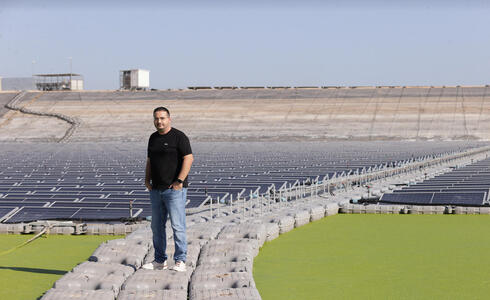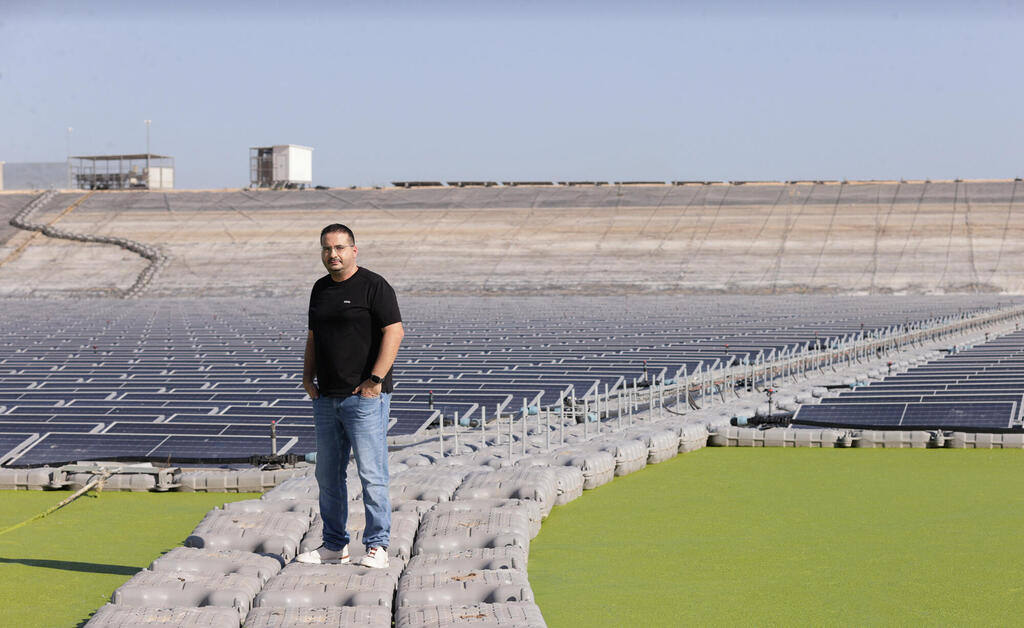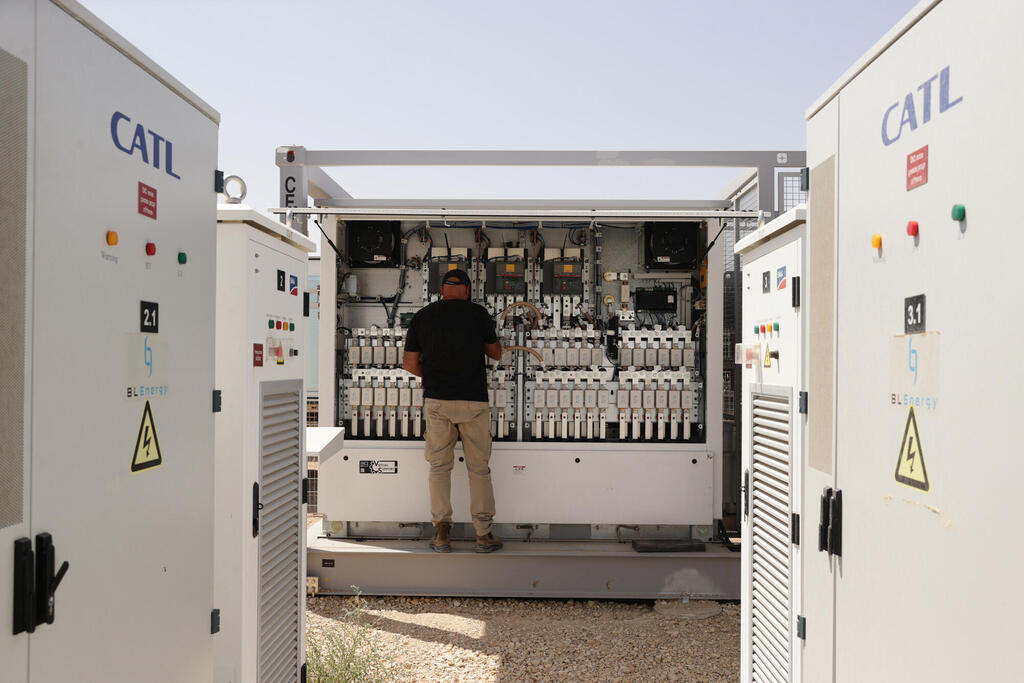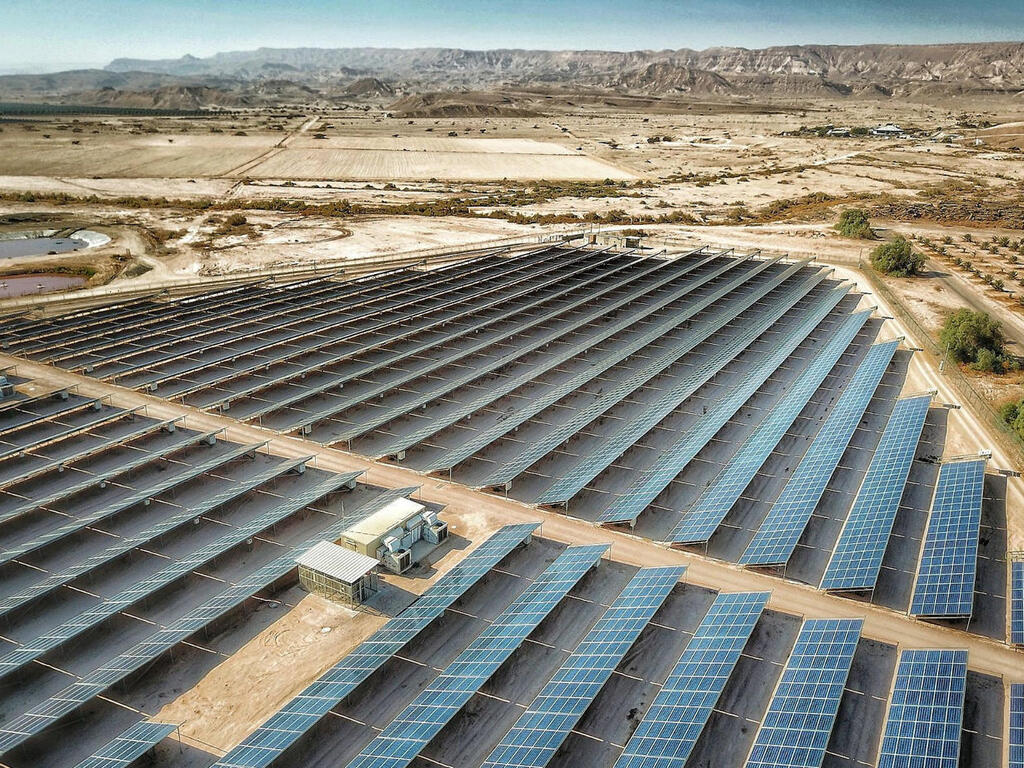
Spark of genius: Kibbutzim's quest for profit and planet-saving sustainability
Kibbutzim strike gold with energy storage investments, reaping profits and greening the grid
Kibbutz Nir Yitzhak, located about 3.5 kilometers from the Gaza Strip border, is mainly known for its close proximity to rocket fire from Gaza. But now it's a period of calm, and Yigal Avin, a member of the community and head of the solar energy development sector, enthusiastically leads me to the kibbutz's latest innovation: an electricity storage facility erected on the kibbutz grounds near the border and the main road.
From the outside, it appears to be a large white shipping container. When you open its doors, dozens of black batteries, similar to those found in Tesla vehicles, can be seen neatly stacked on top of each other and connected by cables.
But Yigal sees something entirely different; neither containers nor batteries, but a business model. "It's very profitable," he explains. "The government encourages us to supply electricity during peak hours and pays an additional 45 agorot (approximately 12 cents) for every kilowatt you deliver. That's really the whole idea: generate or store electricity during non-peak hours when it's cheap, and sell it at a premium a few hours later in the evening when demand spikes.”
Many kibbutzim have adopted this idea, investing millions in setting up solar power systems and large storage facilities. "We started with solar systems on the roofs of chicken coops and barns," says Yigal, "but due to infrastructure limitations in the country's power grid, we reached the maximum production capacity and couldn't generate more electricity. Then, in collaboration with Nofar Energy, we decided to establish a storage facility. Every time we hit the production limit, we divert the excess electricity to storage, and later we release it to the grid. This allows us to add an additional 2.5 megawatts of production and sell during peak hours."
The storage facility in Nir Yitzhak was the first one established in Israel in 2021. The project’s costs, approximately NIS 12 million ($3.15 million), were split between the kibbutz and Nofar Energy, a renewable energy company. "By 2024, the project is expected to turn profitable and will add several hundred thousand shekels to the kibbutz's annual income," says Yigal. "Besides that, it also enables the kibbutz to save on electricity consumption, by using our own electricity rather than buying from the electricity company. This also gives us electrical stability - something lacking in the periphery - and other benefits without investing significant manpower or costs."
Just 5 kilometers away stands another energy storage facility, also a joint initiative of a kibbutz and a commercial company, Kibbutz Holit and Doral Energy. The facility itself is located outside the kibbutz, near a vast solar panel field, surrounded by a high fence. Before entering, I was given a safety briefing with the site manager. "Electrocution from the panels is immediate death," he says, remaining tense throughout the tour.
Inside the facility, we met Yoni Hantzis, the Deputy CEO of Doral. "In Israel, the sun sets at 5:00 or 6:00 PM and solar energy production stops abruptly. Conversely, the main electricity consumption today is in the evening hours, so one of the only ways to continue supplying green energy is through energy storage."
Holit is the first project in Israel to combine solar energy and energy storage. Besides this one, Doral has storage facilities across other kibbutzim, including Reshafim, Kfar Ruppin, Gadot, Yotvata, Yahel, Megiddo, Yakum, Givat Brenner, Kerem Shalom, Meirav, Hukok, Gvulot, and Ma'ale Gilboa. "Today, it's nearly impossible to establish a solar facility without storage because at 12:00, when the sun is at its peak, it's very difficult to connect to the national power grid," says Hantzis. "It's overloaded and can't accommodate additional electricity. To speed up the connection of solar systems you have to integrate storage and distribute electricity in the evening when the grid needs it."
From kibbutzim to Bedouin communities
Israel doesn't promote sufficient renewable energy production and is far from achieving its modest goals in this field. However, there is recognition of the importance of sustainable storage solutions. A national research institute is set to be established for electrochemical storage, in collaboration with Bar-Ilan University and the Technion, with an investment of NIS 130 million ($35 million).
The increasing dependence on renewable energy was keenly felt this past June, when a heatwave pushed household electricity consumption to its peak, while haze and high cloud cover affected the solar panel's production capacity. Power stations weren't activated on time, and around 300,000 households were disconnected in a coordinated operation. Today, renewable energy provides about 10% of Israel's energy, but on certain days, it becomes critical for maintaining a normal life. For example, on July 29 this year, one of the peak days of electricity consumption, 22% of it came from renewable energy sources, mostly solar.
Storage solutions were developed to overcome dependence on weather, and the kibbutzim that host them have become the country's primary solar power producers in recent years, thanks to technological advances that increased storage capacity and reduced costs. But the story of energy storage in Israel cannot be told without starting with Ofer Yannay, Founder of Nofar Energy, who also recently acquired the Hapoel Tel Aviv basketball team. "I founded Nofar in 2010," he recalls. "I tried to set up solar panels in agricultural areas, and I encountered regulatory obstacles from the Ministry of Agriculture, the Israeli Electricity Authority, regional and local committees, and others who simply acted irrationally." Yannay found a solution to the regulatory problem on the roofs of chicken coops and barns in kibbutzim: "Since it's a built-up area, I encountered fewer regulatory issues.”
Yannay understood that the solution lay with the kibbutzim, and Nofar began to create a partnership model with them, by which the kibbutzim provide land and favorable regulatory conditions, and Nofar handles fundraising, building the panels, and storage facilities. In 2018, Yannay says, "I created a model for future electricity consumption based on data I collected quarterly, and realized that the electricity grid was about to be blocked."
What does that mean?
"You can compare the electrical cables to roads. Most of the renewable energy is produced in peripheral areas, in the Arava and the southern Negev, where the roads are narrow. The highways are at the center, and when you increase the number of vehicles on narrow roads, congestion occurs, which could melt the cables."
Yannay realized that the only way to bypass the congestion was to store electricity in the periphery during sunny midday hours and then distribute it to the central grid when it's not overloaded in the evening hours. He asked his team to find energy storage solutions that would serve as the basis for the business model. Fate intervened, and the electric vehicle wave led to mass production of cheaper lithium-ion batteries, which are also used for solar energy storage. Advancement in technology, thanks to Tesla, lengthened the lifespan of batteries to 15-20 years, allowing for long-term investment. This was more or less the moment when the Israel Electric Corporation began to issue tenders for large-capacity solar farms in conjunction with energy storage.
Following the success of the first facility in Nir Yitzhak, Nofar Energy started developing similar facilities. Today, they have seven more in kibbutzim such as Shoval, Gevim, Or HaNer, Geshur, Tze’elim, Sde Eliyahu, and Sa'ad, and there are larger future plans. "In addition to the eight existing storage projects, Nofar is involved in 38 more projects, all in different stages of development and all in kibbutzim," says Yannay. "Today, during peak moments in the summer afternoons, we sometimes reach such high production levels that half of the energy produced in Israel is renewable solar energy. If every kibbutz generates 10 megawatts/hour in the future, it would be enough for the entire grid's needs forever."
You sound extremely optimistic at a time when everyone is talking about an electricity crisis.
"The electricity crisis is a discussion used by those who want to promote gas power stations in the center of the country."
But most of the consumption is in the center, and there's a limit to the flow of electricity from the Negev and the Galilee.
"That's correct; there's a real problem here. Electricity consumption in the center increases by about 3% every year, and one way to deal with this demand is to distribute generation. In other words, build small power stations in Tel Aviv that operate on gas and can supply electricity, for example, to a high-rise building. Another option is to transfer electricity from the periphery and place storage facilities in Tel Aviv. They would absorb energy during the night hours, store it, and release it in the morning. This way, you don't need gas and there's no pollution. This seems to me like the ideal solution."
But the authorities don't see it that way?
"We've brought it up several times, but there are major interests of gas producers in play. They have a very strong lobby."
You yourself admitted that there are "bottlenecks" in the electricity grid, and it's challenging to send it from the periphery to the center of the country.
"True, but there's an alternative to bringing electricity from the south without using the electric company's infrastructure."
How do you do that?
"I would be very happy to personally establish a 20-gigawatt electricity line from the Negev at my expense. It will not only reduce electricity prices for consumers but also lead to a larger production of clean solar energy. The electricity in the south is generated in the western Negev, so why can't the electric company build an additional electricity line from the Negev to the center? Because it passes through a Bedouin settlement. They disagree, and for six years now, billions in damages have accumulated."
If the electric company hasn’t been successful, how do you expect to persuade local residents?
“Regarding the Bedouins, I would sit with them in their tent, drink coffee with them, socialize with them, and move their tent a few meters to the side.
"What I'm saying is that solar electricity prices, including storage, are 20% cheaper than gas energy (according to market estimates the price difference is lower, depending on the region and the generation station). According to my theory, gas prices will rise after the selling of the Ashkelon power station. The estimate is that in five or ten years, solar and storage energy will be 50% cheaper than gas, but gas producers have essentially blocked the development of renewable energy because they pushed for the establishment of fossil fuel power stations, missing out on a great opportunity. I travel the world and see how power companies are moving forward because they understand the implications and that solar energy reduces prices. Israel is frozen in time."
The next stop: a meeting in Bnei Brak
It isn't just southern kibbutzim that are joining the energy storage trend. EDF Renewables is a subsidiary of EDF, the French electricity company and one of the largest energy companies in the world. In Israel, they have around 32 fields connected to the grid, providing more than 530 megawatt-hours, making them the largest renewable energy producer in the country. "We have a solar power project with storage under construction in Kibbutz Hafetz Haim in the Harod Valley, and by the end of the year, we'll install five more," says Nadav Barkan, Vice President of Business Development.
Is there really a need for so many storage facilities in Israel?
"Israel suffers from two main problems: firstly, it is an energy island. This means we don't have the support of neighboring countries because our electricity grid is not connected to theirs. In addition, Israel lacks diversity in energy sources; we mainly have solar and gas (wind doesn't really work here), meaning that if one of these sources is impacted, it requires a rapid response from an energy source to prevent the grid from collapsing. Storage batteries can provide the solution and supply a substantial amount of electricity in a very short time."
EDF is also building a kosher battery project in Bnei Brak, which will replace a solar generator. "During the week, these batteries will sell electricity to end customers," Barkan explains. "Electricity will be purchased during cheap production times and sold at a higher price. Towards the Sabbath, the batteries will be charged and supply electricity to the community for 24 hours. It will also reduce costs because today communities pay a lot due to the high cost of operating generators, and it will also cut down on air pollution."
Adapting the system to electricity consumption patterns
In addition to the giant companies, dozens of smaller companies are also trying to carve out a slice of the solar energy bonanza. One of them is Ageera, a startup founded by Idan Liebes and Aviya Grosman. Liebes was an energy and environmental policy researcher at the Samuel Neaman Institute at the Technion, while Grosman led Greenspot Smart Mobility, which deals with electric vehicle charging infrastructure. The two of them established a company for electric vehicle charging but quickly realized that the profits lay in energy storage on kibbutzim.
They partnered with Kfar Masaryk near Acre, and since January have been operating an energy storage facility there after receiving about half a million shekels ($131,000) from the Ministry of Innovation and Bank Leumi. "We saw that the trend in green energy is energy storage, and we understood that it would be the next big thing," says Liebes. "In the kibbutz, we learned that the big questions were how to manage electricity properly for all users."
The project in Kfar Masaryk is also connected to solar panels and is based on charging a giant battery during cheap electricity hours and selling it during peak hours. However, the startup's focus is on developing a control system that will allow optimal utilization of renewable energy and backup during power outages. Among other things, the startup is developing a pilot project that uses electric vehicle batteries to sell electricity during peak hours when the cars are not in use.
"We realized that using batteries can save the kibbutz millions of shekels per year, and the same can be done for smaller entities like hotels and shopping malls," says Liebes. "The problem is that each of these entities has a unique energy consumption pattern. In the kibbutz, for example, people come home in the evening and turn on electrical appliances. In malls, most of the commerce happens in the afternoon, while schools need electricity in the morning and afternoon. We developed a management and control system that can learn the electricity consumption patterns and efficiently store and distribute energy accordingly."
Why not sell directly to large private customers?
Another significant player in the field is the company Enlight Renewable Energy, which, at the end of June completed the construction of a massive solar field and energy storage facility that will supply 40 megawatt-hours to the Sdot Negev Regional Council. Enlight, traded in the Tel Aviv Stock Exchange and on the Nasdaq, specializes in the establishment and operation of solar fields and wind turbines for electricity generation. Enlight CEO Gilad Yavetz, also opposes the establishment of another gas-based power station in central Israel to overcome the electricity shortage. "There is excess production in the south of the country," he says, "and today, with the help of storage systems, it is possible to distribute it to central Israel during peak hours and solve many of the problems. Not to mention that it is a clean alternative to polluting power stations. Storage has now reached very favorable prices, and it is much cheaper than natural gas."
Instead of waiting for the electric company, energy storage companies decided to sell directly to large private customers. "Today, we sell our storage facilities to companies like Amdocs, for example," says Yavetz. "It suits their consumption profile, which prefers green electricity, and it's also 10% cheaper for them."
There will be even more motivation to sell green electricity to private customers in January when the reform of The Electricity Authority comes into effect, allowing the purchase of green electricity directly from energy producers. From then on, every kibbutz or company with solar panels will be able to sell directly to private consumers. "The regulation will allow us to sell green electricity in the free market, and this is happening thanks to the ability to store energy," says Hantzis.
Is storage capacity the key?
"Exactly. If I want to sell green energy to a company like Melisron (an Israeli commercial real estate company that operates many malls), for example, and the peak consumption time in the malls is in the evening when there is no sunlight, it would be impossible without storage because there is no sun at that time. With storage, it's possible."
You're still dependent on the electric company's infrastructure.
"Yes, we transfer the electricity through their infrastructure, and then we deal with the 'transfer' to the client, such as Melisron, who buys it from us. These are essentially virtual transactions.
"For example, we are now establishing a huge solar field in Kibbutz Yotvata, and in the evening, I get 6.5 megawatts from the batteries there. It's likely that this energy will go to Eilat, and if I make an electricity deal with a hotel in the city, they will receive electricity from the electric company's grid, but we 'paint' our megawatts as green, ensuring that they get green electricity. This is good for the companies' image, and some also work with the European Union, which requires them to use such electricity.
"The basic calculation is that an investment of about one million shekels ($262,867) is required for a storage capacity of one megawatt-hour, including the required connections and wiring. The price paid ranges from 30 agorot in off-peak hours to 70 agorot in peak hours per kilowatt-hour. The estimates are that profitability will be 12-15%, and a battery is expected to last 15 years, with Tesla batteries even lasting 20 years."
Batteries aren’t as cheap as you think
Shaul Goldstein, CEO of Noga, the government company that manages the national electricity grid, tempers this enthusiasm. According to him, storage batteries cannot solve all of Israel's electricity problems because "it's hard to rely solely on batteries, especially when it comes to long power outages. In California, for example, the batteries did not provide the expected electricity. Sometimes there are also problems with the batteries themselves, beyond their capacity limitations." A week of rain or heavy cloud cover, he says, prevents recharging the batteries and can lead to an electricity shortage. In addition, says Goldstein, "solar power providers who store electricity in batteries do not like to be told when to release it; they prefer to maximize their profits.
"They first ensure that the batteries are fully charged during the day and then release the electricity in the evening because they claim that there is excess production in the morning. But right now, there is no excess production, and we are using most of the electricity they provide in the morning. Furthermore, during the winter, when it's rainy and cloudy and there is no solar charging, we need to sell them electricity to recharge the batteries during off-peak hours. So, I need to operate more standby stations, which they don't like because they are often turned on and off due to maintenance issues. Add to that the fact that the cost of lithium batteries is not as cheap as they tell you, and consider their limited lifespan and the question of where to store them when they die. At this stage, there’s a lot of talk but no one has any real solutions."
















